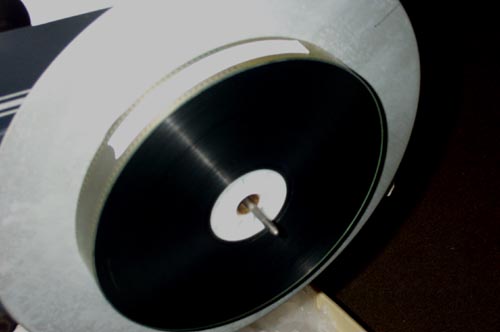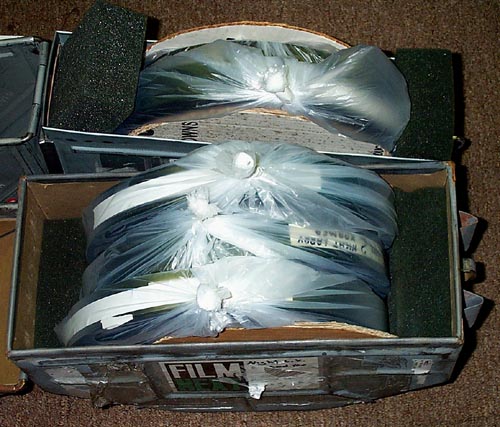|
|
This topic comprises 2 pages: 1 2
|
|
Author
|
Topic: Bad Film Shipping Practices
|
Ian Price
Phenomenal Film Handler

Posts: 1714
From: Denver, CO
Registered: Jun 99
|
 posted 12-13-2000 06:18 PM
posted 12-13-2000 06:18 PM




I just received a print, loose, on cores, in film cans with no separation, so that the larger reels film wandered across the whole can.Only film on reels should be shipped in film cans. Film on cores should be shipped in individual tins or at least in cardboard boxes with pieces of cardboard separating each reel. How can I send this print back in order to make a statement? I was thinking of shrink-wrapping each real and putting in cardboard separators. The print is also dirty (Film-Guard® will come in handy here) with shoe polish and each frame marked as well. The last time it was built up they used white splicing tape. The only other thing I can think of is to dump the entire film in one large garbage bag with a note saying, “Please, try again.”
| IP: Logged
|
|
|
|
Randy Stankey
Film God

Posts: 6539
From: Erie, Pennsylvania
Registered: Jun 99
|
 posted 12-13-2000 08:56 PM
posted 12-13-2000 08:56 PM




Have had that happen many-a-time. When you get prints from places like New Yorker and the like, that's the NORM!How to make a statement: Fix it and fix it right...
Clean the film with FG. Get all the shoe polish and other crap off it and fix all the bad splices and chopped-up frames. When you're done running it, break it down right.... All heads out, CCW unwinding orientation, head and tail leaders on the right way. ie: Be a professional. When you put it back in the can, make sure each reel is marked and taped down properly. Bag each real in a plastic trash liner and type up a little stick-on label on your computer that says something like, "This print inspectded by..." and then write your name and date on it. Stick one of those on each reel. (I use them in lieu of tape) The people who do the kind of crap you describe won't be impressed with your rantings and ravings about how stupid they are. (They are too stupid to even comprehend) You will, however impress a few people by acting professionally. You can catch more flies with honey, so to speak. If the print is really bad, the only other thing you can do is order a replacement. Don't even touch the print you have. Just put it back in the can and wait for the replacement. (Unless your "Go show" is imminent and you HAVE to use that print.)
| IP: Logged
|
|
|
|
|
|
John Pytlak
Film God

Posts: 9987
From: Rochester, NY 14650-1922
Registered: Jan 2000
|
 posted 12-14-2000 06:45 AM
posted 12-14-2000 06:45 AM





I agree with Randy and Brad:Make the best of a bad situation, and fix and clean the print as necessary (unless you can get a good replacement print in time). Document the hours of work you needed to repair the damage, and send the exchange and distributor an itemized invoice for these services. They may not give any reimbursement, but it will be noticed, and give you a negotiating point when dealing with that distributor in the future. Randy is absolutely correct: we should always act as the skilled PROFESSIONALS we are, and do all we can to have the best presentation quality. Don't make the audience suffer or risk additional damage to the print because of someone else's incompetence. But do "be the squeaking wheel" to draw attention to the problems. ------------------
John P. Pytlak, Senior Technical Specialist
Worldwide Technical Services, Entertainment Imaging
Eastman Kodak Company
Research Labs, Building 69, Room 7419
Rochester, New York, 14650-1922 USA
Tel: 716-477-5325 Fax: 716-722-7243
E-Mail: john.pytlak@kodak.com
| IP: Logged
|
|
John Walsh
Film God

Posts: 2490
From: Connecticut, USA, Earth, Milky Way
Registered: Oct 1999
|
 posted 12-14-2000 09:37 AM
posted 12-14-2000 09:37 AM




Same thing here... About a week ago I ran a print of "Proof of Life" where the heads and tails were attached with masking tape; several splices on top of splices at the ends; it was wound very loosely, so wraps of film went everywhere. It arrived heads out, which was no help, since I had to wind it forward to the end to properly attach the tail leader.The thing that really pissed me off was the film hadn't even been released yet,and already it was in poor shape. I'd list the print number and everything, but I know that whoever had it doesn't post here, and in fact, wouldn't care.
| IP: Logged
|
|
|
|
John Pytlak
Film God

Posts: 9987
From: Rochester, NY 14650-1922
Registered: Jan 2000
|
 posted 12-14-2000 02:34 PM
posted 12-14-2000 02:34 PM





Enforcement of "fines" for print damage or poor practice has to come from the owner of the print, which is the DISTRIBUTOR. And if they don't know about the damage (i.e. pay to have the exchange actually INSPECT the film or hear about damage from a theatre), there is no way to prove who caused the damage and when. The best way to put the blame where it belongs is to report any significant print damage immediately, to BOTH the distributor and the film exchange. Even if the print is okay, but there is a problem (e.g., broken shipping reel, damaged case, loose winding, poor splicing practices, more than one lab splice per reel) you should report it. If significant effort is needed to repair/clean the print, document it. Ask for replacement reel(s) if there is damage or a problem that significantly hurts presentation quality. Follow-up any phone call with written documentation, including returning any damaged film, bad splices, etc. that needed to be removed. Keep a print log for each print, documenting what you find on print inspection, any problems that develop during the run, and which equipment it has been run on (i.e., moving print between auditoriums, interlocking). Here's the hard part: if you severely damage a print through accident or negligence (e.g., dumping a print on a dirty floor, misthreading that causes a bad scratch), admit it. Sending a severly damaged print on to the next theatre without reporting it is very unprofessional.
------------------
John P. Pytlak, Senior Technical Specialist
Worldwide Technical Services, Entertainment Imaging
Eastman Kodak Company
Research Labs, Building 69, Room 7419
Rochester, New York, 14650-1922 USA
Tel: 716-477-5325 Fax: 716-722-7243
E-Mail: john.pytlak@kodak.com
| IP: Logged
|
|
|
|
|
|
|
|
Ian Price
Phenomenal Film Handler

Posts: 1714
From: Denver, CO
Registered: Jun 99
|
 posted 12-16-2000 03:11 PM
posted 12-16-2000 03:11 PM




Scott, yes they were shipped in the regular octagonal film cans. I am very familier with the way the Russians and Chinese ship films in idividual film tins. I have no problem with that. Even film collectors will ship on cores, flat in a nice cardboard box with cardboard dividers.If the print had been here a week for a regular engagement I would have asked for a new print. Or I would have asked for reels to ship back on. This print was here for one showing only. I was able to run it through Film-Guard once. I made shure the print was wound tight on the cores and I put a generous piece of white artist tape to hold the end from coming loose.  I placed each part in a trash liner before placing each part in the film can liners. This is a trick I learned from Brad Miller. I don't do it for every print, as he does.  The foam rubber was part of the orgional packaging. I hope the next projectionist appriciates what I have done. More than likely he or she will open up the cans and exclaim, "What the Fuck!"
| IP: Logged
|
|
|
|
|
|
|
|
All times are Central (GMT -6:00)
|
This topic comprises 2 pages: 1 2
|
Powered by Infopop Corporation
UBB.classicTM
6.3.1.2
The Film-Tech Forums are designed for various members related to the cinema industry to express their opinions, viewpoints and testimonials on various products, services and events based upon speculation, personal knowledge and factual information through use, therefore all views represented here allow no liability upon the publishers of this web site and the owners of said views assume no liability for any ill will resulting from these postings. The posts made here are for educational as well as entertainment purposes and as such anyone viewing this portion of the website must accept these views as statements of the author of that opinion
and agrees to release the authors from any and all liability.
|

 Home
Home
 Products
Products
 Store
Store
 Forum
Forum
 Warehouse
Warehouse
 Contact Us
Contact Us




 Printer-friendly view of this topic
Printer-friendly view of this topic


















 that the owner of the print doesn't care enough about their property to provide proper shipping on reels or in individual cans.
that the owner of the print doesn't care enough about their property to provide proper shipping on reels or in individual cans.


